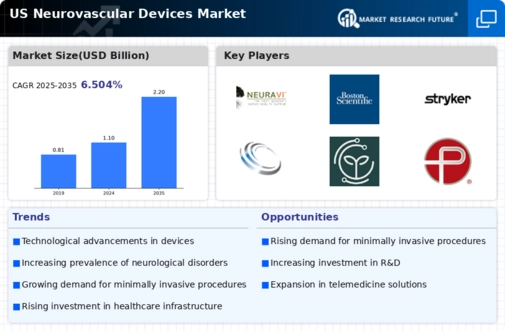Growing Awareness and Education
There is a notable increase in awareness and education regarding neurological health among both healthcare professionals and the general public. Campaigns aimed at educating individuals about the signs and symptoms of neurological disorders are becoming more prevalent. This heightened awareness is likely to lead to earlier diagnosis and treatment, thereby increasing the demand for neurovascular devices. Furthermore, healthcare providers are receiving more training on the latest technologies and treatment protocols, which enhances their ability to utilize these devices effectively. As a result, the neurovascular devices market is expected to benefit from this trend, as more patients seek timely interventions and advanced treatment options.
Investment in Research and Development
Significant investment in research and development (R&D) is propelling the neurovascular devices market forward. Companies are increasingly allocating resources to innovate and enhance device efficacy, safety, and usability. The US government, alongside private entities, has been funding numerous initiatives aimed at advancing neurovascular technologies. For instance, the National Institutes of Health (NIH) has dedicated millions of dollars to research projects focused on stroke prevention and treatment. This influx of funding is likely to lead to the introduction of cutting-edge devices, which could capture a larger market share and improve clinical outcomes. As a result, the neurovascular devices market is poised for growth, driven by continuous innovation and technological advancements.
Technological Integration in Healthcare
The integration of advanced technologies such as artificial intelligence (AI) and machine learning into healthcare is influencing the neurovascular devices market. These technologies are being utilized to enhance diagnostic accuracy and treatment planning, leading to improved patient outcomes. For instance, AI algorithms can analyze imaging data to identify potential neurovascular issues more efficiently. This technological integration not only streamlines workflows but also increases the demand for sophisticated neurovascular devices that can work in tandem with these innovations. As healthcare systems in the US continue to adopt these technologies, the neurovascular devices market is likely to experience significant growth, driven by the need for devices that complement advanced diagnostic tools.
Regulatory Support and Approval Processes
Regulatory support and streamlined approval processes for neurovascular devices are contributing to market growth. The US Food and Drug Administration (FDA) has been working to expedite the review and approval of innovative medical devices, particularly those addressing critical health issues like stroke and aneurysms. This supportive regulatory environment encourages manufacturers to invest in the development of new devices, knowing that they may receive quicker market access. As a result, the neurovascular devices market is likely to see an influx of new products, enhancing competition and providing healthcare providers with a broader range of treatment options. This trend may ultimately lead to improved patient care and outcomes.
Rising Incidence of Neurological Disorders
The increasing prevalence of neurological disorders in the US is a primary driver for the neurovascular devices market. Conditions such as stroke, aneurysms, and arteriovenous malformations are becoming more common, necessitating advanced treatment options. According to recent data, stroke is the fifth leading cause of death in the US, with approximately 795,000 individuals affected annually. This growing patient population creates a substantial demand for innovative neurovascular devices, as healthcare providers seek effective solutions to manage these conditions. The neurovascular devices market is expected to expand as hospitals and clinics invest in advanced technologies to improve patient outcomes and reduce mortality rates associated with neurological disorders.

















Leave a Comment